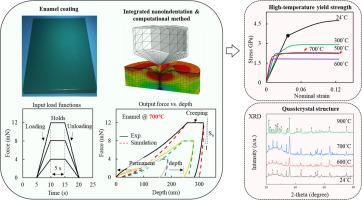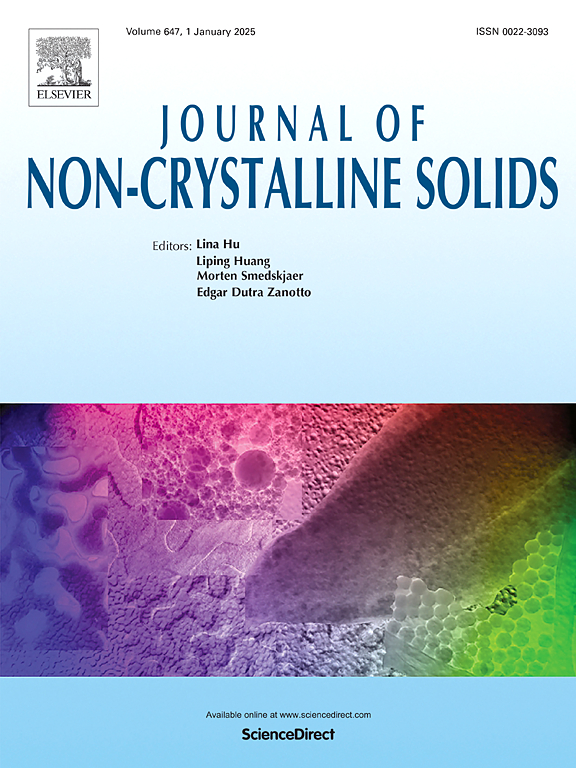揭示高温对搪瓷涂层的影响:粘度、屈服强度、应力-应变行为和结构
IF 3.5
3区 材料科学
Q1 MATERIALS SCIENCE, CERAMICS
引用次数: 0
摘要
搪瓷涂层对于保护关键工程部件免受高温氧化至关重要。了解其机械性能,如粘度、屈服强度、应力-应变行为和模量,对其高温应用至关重要。先前的研究通常是单独探索这些特性,缺乏对它们综合影响的理解。我们的研究使用了集成的高温纳米压痕和有限元方法来精确表征涂层在高温下的粘度、屈服强度和应力应变。通过在牙釉质的控制方程中加入塑性屈服函数,我们的模拟在力-深度和蠕变位移方面与压痕数据很好地匹配。我们发现应力应变随温度的非单调变化。例如,在24 ~ 600℃时,其屈服强度从3.6 ~ 1.7 GPa下降,在700℃时上升到2 GPa。此外,模量有异常增加。XRD分析表明,内部准晶结构的变化与异常的应力-应变行为密切相关。此外,我们使用该方法表征的弹性和粘性参数与塑性性能无关。由此可以将塑性屈服函数从本构方程中剔除,便于建立粘弹性连续体模型和确定高温下搪瓷涂层的相关材料强度。本研究为搪瓷涂层在高温下的力学研究提供了一个更完整的视角,有利于提高搪瓷涂层的工程应用。本文章由计算机程序翻译,如有差异,请以英文原文为准。

Unveiling the influence of elevated temperatures on enamel coating: Viscosity, yield strength, stress-strain behavior and structure
Enamel coatings are crucial for safeguarding key engineering components against high-temperature oxidation. An understanding of their mechanical properties, such as viscosity, yield strength, stress-strain behavior, and modulus, is essential for their high-temperature applications. Prior research typically explored these properties separately, lacking an understanding of their combined impacts. Our study uses an integrated high-temperature nanoindentation and finite-element approach to precisely characterize the viscosity, yield strength, and stress-strain of coatings under high temperatures. By considering material crushing during tip compression and adding a plastic yield function to the enamel's governing equations, our simulations match indentation data well in force-depth and creep displacement. We discovered non-monotonic changes in stress-strain with temperature. For example, their yield strength decreased from 3.6 to 1.7 GPa between 24 ˚C and 600 ˚C, then increased to 2 GPa at 700 ˚C. Additionally, there was an abnormal increase in modulus. XRD analysis shows a strong connection between internal quasi-crystalline structure changes and the unusual behavior of the stress-strain. Moreover, the elastic and viscous parameters, which we characterized using the proposed method, are independent of plastic properties. As a result, the plastic yield function can be removed from the constitutive equations, facilitating the establishment of a viscoelastic continuum model and determination of related material strength for the enamel coating at elevated temperatures. This research offers a more complete view of enamel coating mechanics at high temperatures, beneficial for enhancing their engineering applications.
求助全文
通过发布文献求助,成功后即可免费获取论文全文。
去求助
来源期刊

Journal of Non-crystalline Solids
工程技术-材料科学:硅酸盐
CiteScore
6.50
自引率
11.40%
发文量
576
审稿时长
35 days
期刊介绍:
The Journal of Non-Crystalline Solids publishes review articles, research papers, and Letters to the Editor on amorphous and glassy materials, including inorganic, organic, polymeric, hybrid and metallic systems. Papers on partially glassy materials, such as glass-ceramics and glass-matrix composites, and papers involving the liquid state are also included in so far as the properties of the liquid are relevant for the formation of the solid.
In all cases the papers must demonstrate both novelty and importance to the field, by way of significant advances in understanding or application of non-crystalline solids; in the case of Letters, a compelling case must also be made for expedited handling.
 求助内容:
求助内容: 应助结果提醒方式:
应助结果提醒方式:


